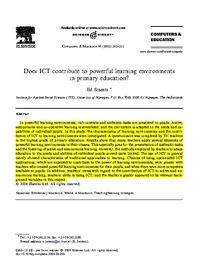Does ICT contribute to powerful learning environments in primary education?Ed Smeets
Erstpublikation in: Computers & Education 44 (2005) 343–355
Publikationsdatum:
|
 |
 Diese Seite wurde seit 6 Jahren inhaltlich nicht mehr aktualisiert.
Unter Umständen ist sie nicht mehr aktuell.
Diese Seite wurde seit 6 Jahren inhaltlich nicht mehr aktualisiert.
Unter Umständen ist sie nicht mehr aktuell.
 Zusammenfassungen
Zusammenfassungen
In powerful learning environments, rich contexts and authentic tasks are presented to pupils. Active, autonomous and co-operative learning is stimulated, and the curriculum is adapted to the needs and capabilities of individual pupils. In this study, the characteristics of learning environments and the contribution of ICT to learning environments were investigated. A questionnaire was completed by 331 teachers in the highest grade of primary education. Results show that many teachers apply several elements of powerful learning environments in their classes. This especially goes for the presentation of authentic tasks and the fostering of active and autonomous learning. However, the methods employed by teachers to adapt education to the needs and abilities of individual pupils proved quite limited. The use of ICT in general merely showed characteristics of traditional approaches to learning. Chances of using open-ended ICT applications, which are expected to contribute to the power of learning environments, were greater with teachers who created powerful learning environments for their pupils, and when there were more computers available to pupils. In addition, teachers' views with regard to the contribution of ICT to active and autonomous learning, teachers' skills in using ICT, and the teacher's gender appeared to be relevant background variables in this respect.
Von Ed Smeets im Text Does ICT contribute to powerful learning environments in primary education? (2005)  Dieser Text erwähnt ...
Dieser Text erwähnt ...
 Personen KB IB clear | Jane Howland , David H. Jonassen , Rose M. Marra , Joi Moore | |||||||||||||||||||||||||||
 Fragen KB IB clear | Was bringt Computereinsatz in der Schule?
Wo stehen die Computer in der Schule?Where are the computers located in a school? | |||||||||||||||||||||||||||
 Aussagen KB IB clear | Computerräume in Schulen sind nicht mehr zeitgemäss. | |||||||||||||||||||||||||||
 Begriffe KB IB clear | GenderGender , ICTICT | |||||||||||||||||||||||||||
 Bücher |
|
 Zitationsgraph
Zitationsgraph
 Zitationsgraph (Beta-Test mit vis.js)
Zitationsgraph (Beta-Test mit vis.js)
 4 Erwähnungen
4 Erwähnungen 
- The impact of primary school teachers’ educational beliefs on the classroom use of computers (R. Hermans, Jo Tondeur, Johan van Braak, Martin Valcke)


- Revisiting and reframing use - Implications for the integration of ICT (Lorrae Ward, Judy M. Parr)


- Teacher Technology Change - How Knowledge, Confidence, Beliefs, and Culture Intersect (Peggy A. Ertmer, Anne T. Ottenbreit-Leftwich) (2010)


- Does ICT matter for effectiveness and efficiency in mathematics education? (Kristof De Witte, Nicky Rogge) (2014)


 Anderswo finden
Anderswo finden
 Volltext dieses Dokuments
Volltext dieses Dokuments
 |  Does ICT contribute to powerful learning environments in primary education?: Artikel als Volltext ( Does ICT contribute to powerful learning environments in primary education?: Artikel als Volltext ( : :  , 169 kByte; , 169 kByte;  : :  Link unterbrochen? Letzte Überprüfung: 2020-11-28 Letzte erfolgreiche Überprüfung: 2019-05-11) Link unterbrochen? Letzte Überprüfung: 2020-11-28 Letzte erfolgreiche Überprüfung: 2019-05-11) |
 Anderswo suchen
Anderswo suchen 
 Beat und dieser Text
Beat und dieser Text
Beat war Co-Leiter des ICT-Kompetenzzentrums TOP während er Dieser Text ins Biblionetz aufgenommen hat. Die bisher letzte Bearbeitung erfolgte während seiner Zeit am Institut für Medien und Schule. Beat besitzt kein physisches, aber ein digitales Exemplar. Eine digitale Version ist auf dem Internet verfügbar (s.o.). Aufgrund der wenigen Einträge im Biblionetz scheint er es nicht wirklich gelesen zu haben. Es gibt bisher auch nur wenige Objekte im Biblionetz, die dieses Werk zitieren.










 Biblionetz-History
Biblionetz-History